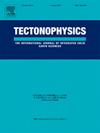北美的高分辨率地图显示,地幔过渡带上下有许多低速带
IF 2.6
3区 地球科学
Q2 GEOCHEMISTRY & GEOPHYSICS
引用次数: 0
摘要
我们研究了横跨北美大陆的大型地震阵列下横跨地幔中部的地震不连续。我们通过一种名为CRISP-RF (Clean Receiver function Imaging with Sparse Radon Filters)的新型降噪滤波器处理高分辨率ps转换地震波(~ 0.5 Hz),从而对地震不连续性的深度分布、清晰度和空间变化提供鲁棒性约束。在上地幔,在地幔过渡带(MTZ)之上,我们观察到在深度从~ 290 km到~ 390 km之间的速度急剧下降。在MTZ以下的下地幔,我们观察到在深度从~ 800 km到~ 1400 km之间的另一个急剧速度下降。下地幔不连续层聚集在~ 940 km深度,而更深的转换层(>;1100公里)不太可能。我们根据两种主要假设来评估我们的结果:玄武岩的富集是由于不完全混合和脱水融化,其中MTZ水被输送到上地幔或下地幔,但很少同时进行。我们得出的结论是,我们的结果更符合这样一种情况:当过去的对流运动将含水的MTZ岩石带入疏水的上下地幔时,组成、挥发性含量和俯冲历史之间的复杂相互作用产生了速度反转界面的不连通区域。本文章由计算机程序翻译,如有差异,请以英文原文为准。
High-resolution mapping of North America suggests numerous low-velocity zones above and below the mantle transition zone
We investigate seismic discontinuities across the middle of Earth's mantle beneath a large seismic array that spans the North American continent. We provide robust constraints on the depth distribution, sharpness, and spatial variation of seismic discontinuities by processing high-resolution Ps-converted seismic waves (∼0.5 Hz) through a novel denoising filter called CRISP-RF (Clean Receiver function Imaging with Sparse Radon Filters). In the upper mantle, above the mantle transition zone (MTZ), we observe a sharp velocity decrease at depths that vary from ∼290 km to ∼390 km. In the lower mantle, below the MTZ, we observe another sharp velocity decrease at depths that vary from ∼800 km to ∼1400 km. The lower-mantle discontinuities cluster at a depth of ∼940 km, while deeper converters (> 1100 km) are less likely. We evaluate our results against two leading hypotheses: basalt enrichment due to incomplete mixing and dehydration melting in which MTZ water is transported into the upper or the lower mantle, but rarely simultaneously. We conclude that our results are more consistent with a scenario where the complex interplay between composition, volatile content, and subduction history, produces disconnected regions of velocity-inversion interfaces when past convective motions bring hydrated MTZ rock into the hydrophobic upper and lower mantles.
求助全文
通过发布文献求助,成功后即可免费获取论文全文。
去求助
来源期刊

Tectonophysics
地学-地球化学与地球物理
CiteScore
4.90
自引率
6.90%
发文量
300
审稿时长
6 months
期刊介绍:
The prime focus of Tectonophysics will be high-impact original research and reviews in the fields of kinematics, structure, composition, and dynamics of the solid arth at all scales. Tectonophysics particularly encourages submission of papers based on the integration of a multitude of geophysical, geological, geochemical, geodynamic, and geotectonic methods
 求助内容:
求助内容: 应助结果提醒方式:
应助结果提醒方式:


